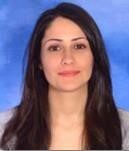
Research Personnel

Eleni Marinou (EM) acquired her PhD diploma on the study of the vertical distribution of desert dust and condensation nuclei over the Mediterranean from the Aristotle University of Thessaloniki (2017). She is an associate scientist at the Institute for Astronomy, Astrophysics, Space Applications and Remote Sensing (IAASARS) of the National Observatory of Athens (NOA) in Greece. She is an atmospheric researcher focusing on the characterization of aerosols, clouds, and their interaction, along with their impact on radiation and dynamics. Her research is mainly based on observations from remote sensing (ground-based and space-borne passive and active lidar/radar techniques) and synergies with models.
She has developed new satellite-based products and global climatologies of aerosols and clouds, focusing on the vertical distribution of desert dust properties and concentration over the Mediterranean, using complementary active and passive remote sensing techniques. She used the developed products in a variety of studies including climate studies, studies of extreme events and ACI, radiation studies, data assimilation, the production of new passive-sensor products, and the evaluation of new developments in atmospheric/dust-transport models. Furthermore, she developed new satellite-based products on CCN and IN concentration over the Mediterranean, using synergistically active and passive remote sensing techniques and evaluated them with airborne in situ measurements.
Since 2014, she has been actively involved in the construction of NOA-PollyXT multi-wavelength lidar system (main operator till 2018, co-PI since 2020), and she participated in the development of retrieval algorithms and products of PollyNET network. She exploited these measurements towards the investigation of aerosol/cloud processes/characteristics and hazards, radiation studies, the development/evaluation of new lidar-based aerosol-related products/retrievals, calibration/validation of products from satellite missions, evaluation of new model aerosol products, and impact assessment studies of lidar data assimilation. Furthermore, she has developed a new methodology for Aerosol – Cloud target classification from combined airborne Lidar – Radar measurements (Lidar – Radar mask) and has investigated the cloud properties over the North Atlantic. Additionally, she investigated the cloud characteristics over the Mediterranean and the dust effect on cloud microphysics, using Cloudnet and CloudSat measurements.
She has participated in 17 international and national projects (4 as a PI) and 13 experimental campaigns (3 as organizer and co-lead). She has more than 55 papers in peer-reviewed journals, 183 conference proceedings, 16 international conferences talks, and 1 monograph university publication. These have resulted in an h-index of 21 and 1722 citations (according to ResearcherID).
She is the co-PI of the PANGEA Aerosol Remote Sensing facility, part of AERONET, PollyNET, EARLINET, ACTRIS, and GAW networks, and a member of the EARLINET council (for 2023 – 2027). She is a member of the inDust, PROBE, HARMONIA, and MIRA community networks. Her expertise and collaboration skills has been recognized by ESA, assigning her to lead the cloud-related calibration/validation activities for the EarthCARE mission through the organisation and consolidation of the global cloud remote sensing community. She co-leads the European ACTRIS aerosol and cloud cal/val activities for the EarthCARE mission. She also co-leads the ESA-NASA-JAXA initiative on the formulation of “Best Practice Protocol for the validation of Aerosol, Cloud, and Precipitation Profiles” for CEOS.
INTERESTS
Atmospheric aerosol and cloud characterization and their interaction, along with their impact on radiation and dynamics. Mainly based on observations from remote sensing (ground-based and space-borne passive and active lidar/radar techniques), on synergies with models, and on validation of satellite porducts.
